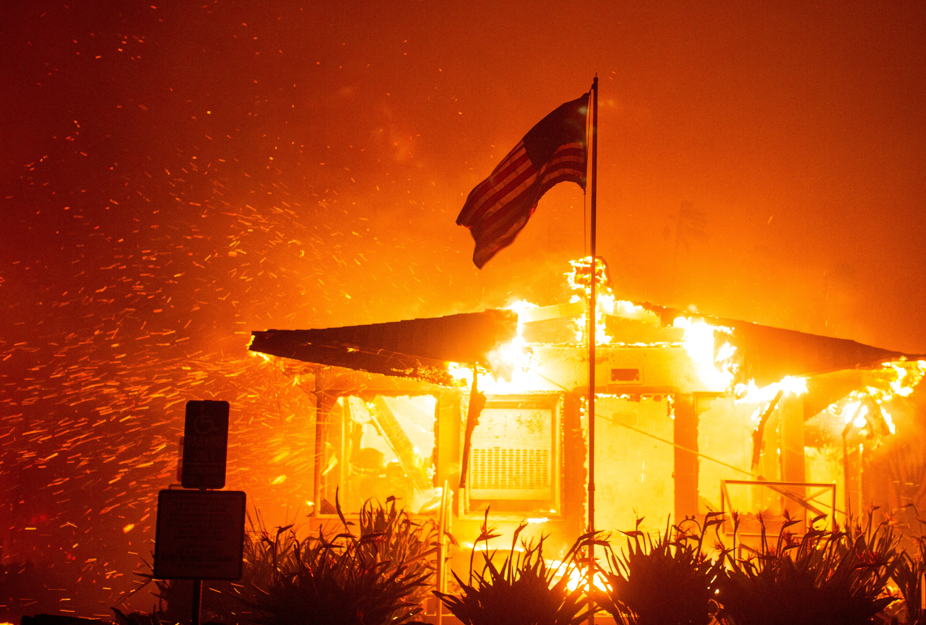Weather conditions in Los Angeles showed slight improvement this Thursday (16), offering brief relief to firefighters who continue battling the devastating wildfires consuming vast areas of the region. However, experts warn that this respite will be short-lived. With forecasts predicting the return of fire-favorable conditions—strong winds and low humidity—by the weekend, the threat of new outbreaks remains high, heightening tensions among authorities, firefighters, and residents.
On Thursday, the National Weather Service (NWS) indicated that winds are expected to shift to an onshore pattern later in the day, bringing higher relative humidity and reducing wind intensity and erratic behavior. This shift will help slow the rapid spread of the flames, at least temporarily. Nevertheless, winds are still blowing at speeds of 25 to 40 km/h in areas east of the city, with gusts reaching up to 64 km/h, maintaining a significant risk environment for new wildfires.

The improvement in conditions led to the expiration of red flag warnings—which signal extreme wildfire danger—in most parts of Los Angeles on Wednesday night (15). However, some specific areas, particularly mountainous regions and valleys east of the city, remain under alert. Meteorological authorities emphasize that the return of strong winds and low humidity on Sunday (19) could reignite risks and possibly lead to new warnings being issued.
In just over a week and a half, the wildfires have consumed an area comparable to the size of Washington D.C., leaving a trail of destruction that is still being assessed. The flames have already claimed at least 25 lives, while more than 12,000 homes and structures have been damaged or destroyed. The losses are not just material; thousands of families face the reality of having lost everything, with entire communities reduced to ashes.
According to Los Angeles County Sheriff Robert Luna, about 200,000 people have been forced to evacuate their homes since the fires began. Of these, approximately 82,400 remain under mandatory evacuation orders, while another 90,400 have been warned they may need to leave their homes at any moment. Managing such a large number of displaced individuals involves massive coordination efforts among temporary shelters, humanitarian organizations, and local authorities.
In the hardest-hit neighborhoods, the destruction is complete. The scene is desolate: entire streets are covered in ash and debris, and in many homes, only chimneys remain, standing as silent witnesses to what were once vibrant residences. Residents who escaped the flames now face the daunting challenge of rebuilding their lives from scratch, grappling with both material and emotional losses.
To combat the fires, a task force of approximately 8,500 firefighters has been mobilized. These professionals come not only from different U.S. states but also from Canada and Mexico, joining forces to help fight the flames. Over the past three days, intensified efforts have managed to halt the fires’ advance in some areas, but the situation remains critical in many regions.
Firefighters face monumental challenges, such as limited access to mountainous and isolated areas where rugged terrain hinders the transport of equipment and personnel. Additionally, the combination of strong winds and dry vegetation creates ideal conditions for flare-ups, even in areas previously considered under control.
The effort also includes aerial support, such as aircraft dropping water and fire retardants, and ground equipment like trucks and excavators. However, the teams are operating under exhausting conditions, working long hours in dangerous environments and often facing the risk of being surrounded by flames.
Beyond the immediate damage, the wildfires in Los Angeles highlight the region’s long-term challenges. The environmental impact is significant, with the destruction of natural habitats and the massive release of air pollutants, worsening air quality issues. Recovery of the devastated areas could take years, requiring not just physical reconstruction but also the revitalization of affected communities.
Experts also point to the need for more robust wildfire prevention and preparedness measures, especially in the context of climate change, which makes extreme events increasingly frequent and intense. This includes proper management of dry vegetation, creating buffer zones in urban areas near forests, and investing in firefighting technologies.
While weather conditions offer a temporary reprieve, the reality is that wildfires will remain a persistent threat to Los Angeles and other parts of California. The imminent return of strong winds and low humidity underscores the urgency for immediate actions and long-term planning to protect lives, property, and the environment.
Meanwhile, the solidarity and resilience of the local community continue to shine amid the devastation, with volunteers, organizations, and authorities coming together to support the displaced and work toward regional recovery. The fight against wildfires is a constant battle but also a testament to collective strength in the face of adversity.
The situation in Los Angeles is a painful reminder of the challenges posed by climate change and extreme conditions for communities worldwide. Although current weather offers a temporary break, the wildfire threat remains constant, requiring ongoing attention from authorities, the population, and crisis management experts.
Yet, amid destruction and suffering, an unshakable spirit of solidarity and resilience emerges. Firefighters, volunteers, neighboring communities, and international organizations are working together to save lives, protect what remains, and support the displaced. This collective effort reflects the human capacity to confront adversity and rebuild from the ashes, both literally and figuratively.
As Los Angeles seeks to recover, there is also a growing need to invest in more effective strategies for preventing and responding to natural disasters. Fighting wildfires is not just a momentary task; it is a long-term struggle that involves adapting to new climate realities and strengthening communities against future threats.
The future will bring similar challenges but also opportunities to learn, innovate, and build more resilient systems. For now, the focus remains on overcoming the present, with hope that safer days lie ahead for all those affected by this tragedy.

